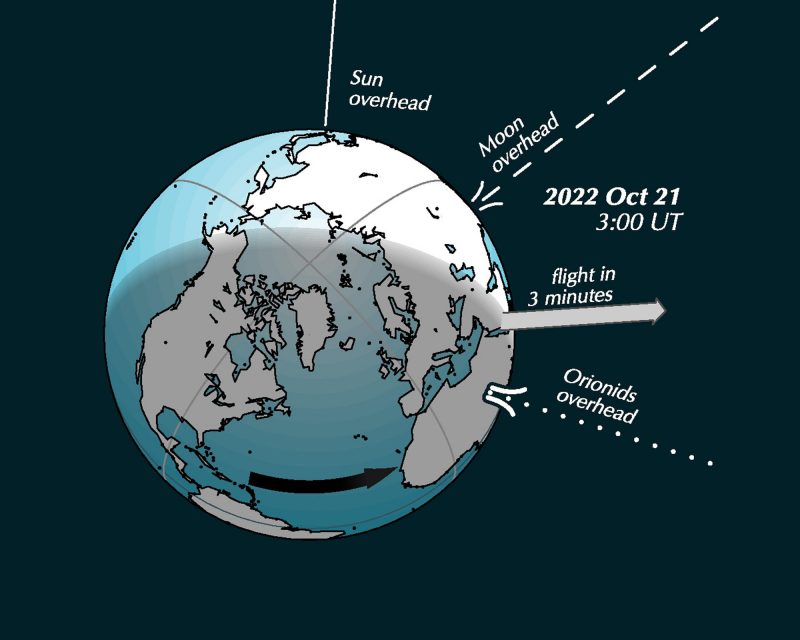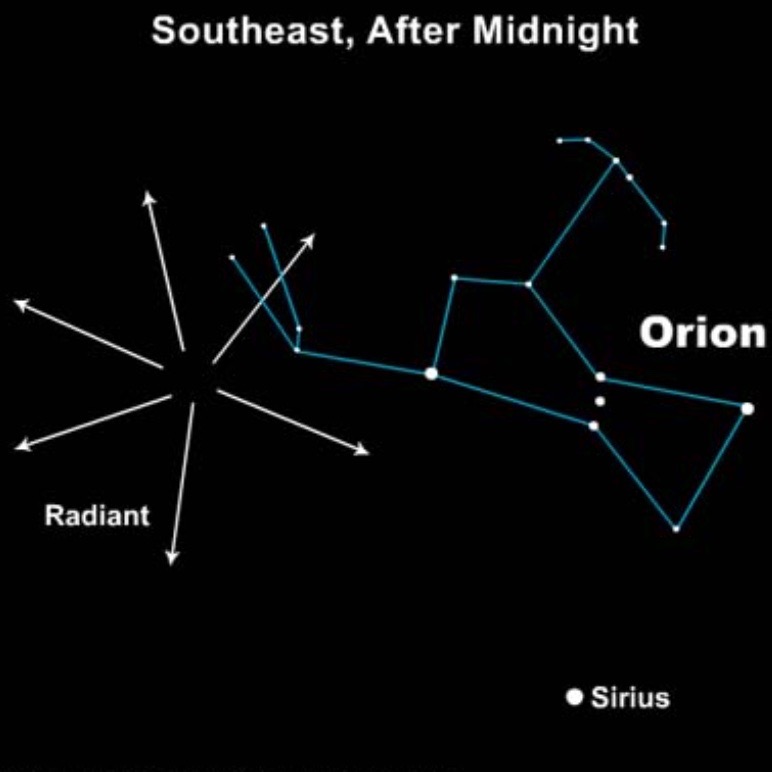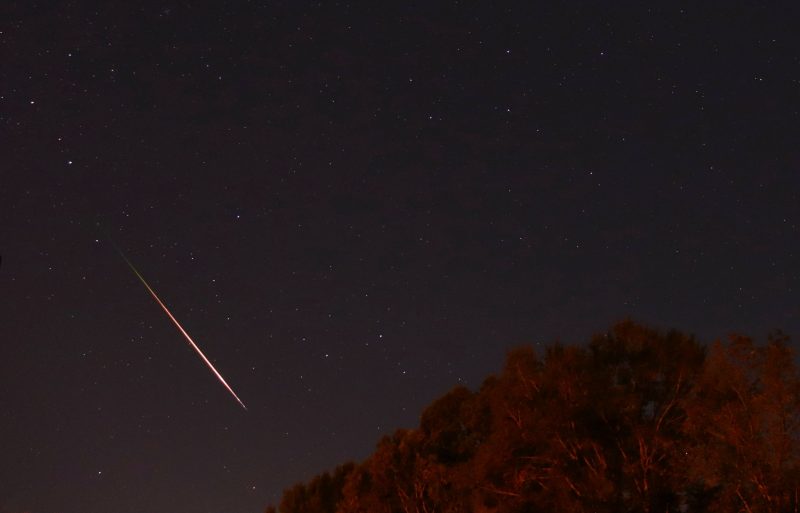2022 Orionid meteor shower: All you need to know
Posted by
Deborah Byrd
October 19, 2022

Orionid meteor shower chart for 2022. Image copyright Guy Ottewell. Used with permission.
In 2022, the Orionid meteor shower should rain down its greatest number of meteors on the morning of October 21, in the light of a lovely little waning crescent moon. But the morning of October 20 is worth a look, too.
When to watch: You might see an Orionid meteor any early morning this week. But, in the first part of the week, the moon will be up between midnight and dawn, obscuring the view on October 17, 18 and 19. By the morning of October 20, with a slimmer moon in the sky and the shower nearing its peak, you’ll likely spot more meteors. And – by the morning of the shower’s peak on October 21 – the moon will be a slim crescent. By then the moon will enhance, not obscure, your enjoyment of 2022’s Orionid meteor shower.
Overall duration of shower: September 26 to November 22.
Radiant: The radiant rises before midnight and is highest in the sky around 2 a.m. local time. See chart below. These meteors radiate from a point near the upraised Club of the constellation Orion the Hunter.
Nearest moon phase: New moon falls at 10:49 UTC on October 25. So, at the Orionids’ predicted* peak, the moon will be in a waning crescent phase and rise in the early morning hours. It’ll be up there, but not too bright. You might even enjoy the waning crescent as you watch for the Orionids in 2022.
Expected meteors at peak, under ideal conditions: Under a dark sky with no moon, the Orionids exhibit a maximum of about 10 to 20 meteors per hour.
Note: These fast-moving meteors occasionally leave persistent trains. The Orionids sometimes produce bright fireballs.
Report a fireball (very bright meteor) to the American Meteor Society: it’s fun and easy!

The Orionids radiate from a point near the upraised Club of the constellation Orion the Hunter. The bright star near the radiant point is ruddy, somber Betelgeuse. You might catch an Orionid meteor any time between about September 26 to November 22. In 2022, the peak morning is October 21, and a waning crescent moon should not interfere with the meteor shower.
The Orionid meteors that we observe come from Halley’s Comet. This comet orbits the sun every 76 years or so, and like steam coming from a locomotive, dust particles are expelled from the comet’s nucleus and are left behind in its path. We intercept this path in late October of each year. The nucleus of the comet loses between three to 10 feet (one to three meters) of material on each passage through the inner solar system. Measuring five by nine miles (eight by 15 km) in size, it can handle eons of orbits around the sun.
The official name for Halley’s Comet is 1P/Halley. It was the first comet to have its return predicted, and Edmond Halley was the one who made that calculation. The comet typically gets bright enough to be easily visible with recorded observations since 240 CE. It is one of only a few comets named not after its discoverer but after the person who calculated its orbit.
Unlike most solar system objects, Halley’s Comet orbits the sun in a retrograde orbit, going around the sun in the opposite direction than we do. Its orbit is also tilted a bit to ours, and it spends most of its time below the plane of our path. Presently, it is at its farthest point from the sun, near the head of the constellation Hydra, too faint to be seen.
Halley’s Comet was last here in 1986 and will return in 2061. But the Orionids never go away, they’re here every October. Go out and see some pieces of this famous comet.

Halley’s Comet, perhaps the most famous of all comets, is parent of both the Eta Aquariid meteor shower in May and October’s Orionid meteor shower. Image via NASA.
The term meteor shower might give you the idea of a rain shower. But few meteor showers resemble showers of rain. And the Orionids aren’t the year’s strongest shower, anyway. Plus they’re not particularly known for storming (producing unexpected, very rich displays). From a dark location you might see 10 to 20 Orionids per hour at their peak. There’s always the element of uncertainty and possible surprise when it comes to meteor showers.

View at EarthSky Community Photos. | Randy Fullerton in Sardis, Mississippi, caught this meteor on October 26, 2021, and wrote: “Shooting southward below Orion’s feet. With the full moon and rains, this is my best capture of a meteor over the last 3 weeks of the Orionids.” Thank you, Randy!
Also, sometimes, an Orionid meteor can be exceptionally bright and break up into fragments.
How will you know if the meteor you see is an Orionid? You’ll know because it’ll come from the shower’s radiant point. See the chart at top.
You don’t need to know Orion, or be staring toward it, to see the meteors. The meteors often don’t become visible until they are 30 degrees or so from their radiant point. And, remember, they are streaking out from the radiant in all directions. They will appear in all parts of the sky.
But if you do see a meteor – and trace its path backward – you might see that it comes from the Club of Orion. And, if so, that meteor will be an Orionid. You might know Orion’s bright, ruddy star Betelgeuse. The radiant is north of Betelgeuse.
Bottom line: In 2022, the Orionid meteor shower should rain down its greatest number of meteors on the morning of October 21, in the light of a lovely little waning crescent moon.
*Predicted peak times and dates for 2022 meteor showers are from the American Meteor Society. Note that meteor shower peak times can vary.
EarthSky’s meteor shower guide for 2022
https://earthsky.org/astronomy-essentials/everything-you-need-to-know-orionid-meteor-shower/?utm_source=EarthSky+News&utm_campaign=9ee62c3015-EMAIL_CAMPAIGN_2018_02_02_COPY_01&utm_medium=email&utm_term=0_c643945d79-9ee62c3015-393775709&mc_cid=9ee62c3015&mc_eid=87f7e1dbd6
Thanks to: https://earthsky.org/
Posted by
Deborah Byrd
October 19, 2022

Orionid meteor shower chart for 2022. Image copyright Guy Ottewell. Used with permission.
In 2022, the Orionid meteor shower should rain down its greatest number of meteors on the morning of October 21, in the light of a lovely little waning crescent moon. But the morning of October 20 is worth a look, too.
The Orionid meteor shower
Predicted peak: October 21, 2022, at 18 UTC.When to watch: You might see an Orionid meteor any early morning this week. But, in the first part of the week, the moon will be up between midnight and dawn, obscuring the view on October 17, 18 and 19. By the morning of October 20, with a slimmer moon in the sky and the shower nearing its peak, you’ll likely spot more meteors. And – by the morning of the shower’s peak on October 21 – the moon will be a slim crescent. By then the moon will enhance, not obscure, your enjoyment of 2022’s Orionid meteor shower.
Overall duration of shower: September 26 to November 22.
Radiant: The radiant rises before midnight and is highest in the sky around 2 a.m. local time. See chart below. These meteors radiate from a point near the upraised Club of the constellation Orion the Hunter.
Nearest moon phase: New moon falls at 10:49 UTC on October 25. So, at the Orionids’ predicted* peak, the moon will be in a waning crescent phase and rise in the early morning hours. It’ll be up there, but not too bright. You might even enjoy the waning crescent as you watch for the Orionids in 2022.
Expected meteors at peak, under ideal conditions: Under a dark sky with no moon, the Orionids exhibit a maximum of about 10 to 20 meteors per hour.
Note: These fast-moving meteors occasionally leave persistent trains. The Orionids sometimes produce bright fireballs.
Report a fireball (very bright meteor) to the American Meteor Society: it’s fun and easy!

The Orionids radiate from a point near the upraised Club of the constellation Orion the Hunter. The bright star near the radiant point is ruddy, somber Betelgeuse. You might catch an Orionid meteor any time between about September 26 to November 22. In 2022, the peak morning is October 21, and a waning crescent moon should not interfere with the meteor shower.
The parent comet of the Orionid meteor shower
From the late, great Don Machholz (1952-2022), who discovered 12 comets …The Orionid meteors that we observe come from Halley’s Comet. This comet orbits the sun every 76 years or so, and like steam coming from a locomotive, dust particles are expelled from the comet’s nucleus and are left behind in its path. We intercept this path in late October of each year. The nucleus of the comet loses between three to 10 feet (one to three meters) of material on each passage through the inner solar system. Measuring five by nine miles (eight by 15 km) in size, it can handle eons of orbits around the sun.
The official name for Halley’s Comet is 1P/Halley. It was the first comet to have its return predicted, and Edmond Halley was the one who made that calculation. The comet typically gets bright enough to be easily visible with recorded observations since 240 CE. It is one of only a few comets named not after its discoverer but after the person who calculated its orbit.
Unlike most solar system objects, Halley’s Comet orbits the sun in a retrograde orbit, going around the sun in the opposite direction than we do. Its orbit is also tilted a bit to ours, and it spends most of its time below the plane of our path. Presently, it is at its farthest point from the sun, near the head of the constellation Hydra, too faint to be seen.
Two meteor showers
The Orionids are produced from Halley’s Comet’s particles on its inbound leg. They are moving in one direction, we are moving in nearly the opposite direction, and the combined speeds produce fast-moving meteors. But we also encounter its particles from its outbound leg when it’s leaving the inner solar system. We reach that point in early May. They produce the Eta Aquariids meteor shower. So this comet generates two meteor showers.Halley’s Comet was last here in 1986 and will return in 2061. But the Orionids never go away, they’re here every October. Go out and see some pieces of this famous comet.

Halley’s Comet, perhaps the most famous of all comets, is parent of both the Eta Aquariid meteor shower in May and October’s Orionid meteor shower. Image via NASA.
Orionid meteor shower peaks during a waning crescent moon
As for most meteor showers, the hours between midnight and dawn are best for the Orionids. A waning crescent moon rises in the early morning hours.The term meteor shower might give you the idea of a rain shower. But few meteor showers resemble showers of rain. And the Orionids aren’t the year’s strongest shower, anyway. Plus they’re not particularly known for storming (producing unexpected, very rich displays). From a dark location you might see 10 to 20 Orionids per hour at their peak. There’s always the element of uncertainty and possible surprise when it comes to meteor showers.

View at EarthSky Community Photos. | Randy Fullerton in Sardis, Mississippi, caught this meteor on October 26, 2021, and wrote: “Shooting southward below Orion’s feet. With the full moon and rains, this is my best capture of a meteor over the last 3 weeks of the Orionids.” Thank you, Randy!
Orionids zip through the sky
If you do see any Orionids in 2022, note that they’re known to be extremely fast meteors, plummeting into the Earth’s atmosphere at about 41 miles (66 km) per second. The meteors in this shower are on the faint side. But they make up for their faintness by leaving [url=https://www.merriam-webster.com/dictionary/meteor train]trains[/url], or ionized gas trails, that last for a few seconds after the meteor itself has gone. Maybe half of the Orionid meteors leave persistent trains.Also, sometimes, an Orionid meteor can be exceptionally bright and break up into fragments.
How will you know if the meteor you see is an Orionid? You’ll know because it’ll come from the shower’s radiant point. See the chart at top.
Orionid meteors radiate from constellation Orion
Meteors in annual showers are named for the point in our sky from which they appear to radiate. The radiant point for the Orionids is in the direction of the famous constellation Orion the Hunter, which you’ll find ascending in the east in the hours after midnight during October. Hence the name Orionids.You don’t need to know Orion, or be staring toward it, to see the meteors. The meteors often don’t become visible until they are 30 degrees or so from their radiant point. And, remember, they are streaking out from the radiant in all directions. They will appear in all parts of the sky.
But if you do see a meteor – and trace its path backward – you might see that it comes from the Club of Orion. And, if so, that meteor will be an Orionid. You might know Orion’s bright, ruddy star Betelgeuse. The radiant is north of Betelgeuse.
Look in different directions
So … in which direction do you look? No particular direction. It’s best to find a wide-open viewing area. Sometimes friends like to watch together, facing different directions. When somebody sees one, that person can call out meteor!Bottom line: In 2022, the Orionid meteor shower should rain down its greatest number of meteors on the morning of October 21, in the light of a lovely little waning crescent moon.
*Predicted peak times and dates for 2022 meteor showers are from the American Meteor Society. Note that meteor shower peak times can vary.
EarthSky’s meteor shower guide for 2022
https://earthsky.org/astronomy-essentials/everything-you-need-to-know-orionid-meteor-shower/?utm_source=EarthSky+News&utm_campaign=9ee62c3015-EMAIL_CAMPAIGN_2018_02_02_COPY_01&utm_medium=email&utm_term=0_c643945d79-9ee62c3015-393775709&mc_cid=9ee62c3015&mc_eid=87f7e1dbd6
Thanks to: https://earthsky.org/






 Sat Mar 23, 2024 11:33 pm by globalturbo
Sat Mar 23, 2024 11:33 pm by globalturbo

